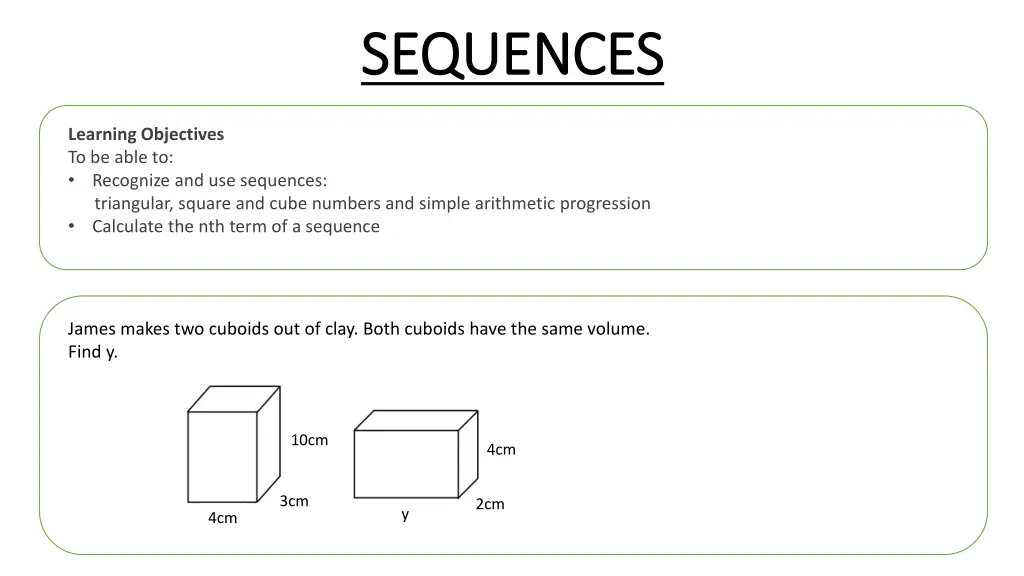
Learning Sequences: Cuboids, Progressions, Fibonacci
Explore sequences involving cuboids, geometric progressions, Fibonacci sequences, and nth term calculations. Understand the patterns in triangular, square, and cube numbers, as well as arithmetic and geometric progressions. Engage with various sequence problems and expand your mathematical skills.
Uploaded on | 0 Views
Download Presentation

Please find below an Image/Link to download the presentation.
The content on the website is provided AS IS for your information and personal use only. It may not be sold, licensed, or shared on other websites without obtaining consent from the author. If you encounter any issues during the download, it is possible that the publisher has removed the file from their server.
You are allowed to download the files provided on this website for personal or commercial use, subject to the condition that they are used lawfully. All files are the property of their respective owners.
The content on the website is provided AS IS for your information and personal use only. It may not be sold, licensed, or shared on other websites without obtaining consent from the author.
E N D
Presentation Transcript
SEQUENCES SEQUENCES Learning Objectives To be able to: Recognize and use sequences: triangular, square and cube numbers and simple arithmetic progression Calculate the nth term of a sequence James makes two cuboids out of clay. Both cuboids have the same volume. Find y. 10cm 4cm 3cm 2cm y 4cm
STARTER Geometric Progression Triangular, Square and Cube Numbers 1, 2, 4, 8, 16, List the first five triangular, square and cube numbers. a) Find the next term of the sequence. b) What is the term-to-term rule? Fibonacci Sequence Arithmetic Progression 0, 1, 1, 2, 3, 5, 8, 21, 17, 13, 9, 5, Find the next three terms of the sequence. a) Find the next term of the sequence. b) What is the term-to-term rule? nth Term 6, 11, 16, 21, 26, a) Find the nth term of the sequence. b) What is the 100th term?
ARITHMETIC AND GEOMETRIC PROGRESSION Here are the first four terms of an arithmetic sequence. 11, 15, 19, 23, a) Write down the next term of the sequence. b) Explain how you found your answer. c) The 100th term of the sequence is 407. Work out the 99th term of the sequence. Here are the first four terms of a geometric sequence. 1, 5, 25, 125, a) Write down the next two terms of the sequence. b) Explain how you find the next term of the sequence.
Your turn Here are the first five terms of a sequence. Find the next two terms for each of the following geometric progressions. 9, 15, 21, 27, 33, 1) 2, 6, 18, 54, a) Write down the next term of the sequence. 2) 256, 128, 64, 32, b) Explain how you found your answer. 3) 2, -4, 8, -16, c) Write down the 9th term of the sequence. d) 302 is not a term in this sequence. Explain why.
FIBONACCI SEQUENCE Find the next three terms of the sequence. 2, 4, 6, 10, Find the next three terms of the sequence. a, 4a, 5a, 9a,
Your turn Find the next three terms of the following Fibonacci-style sequences. 1) Here are the fourth and fifth terms of a Fibonacci-type sequence. , , , 28 , 43 Each term is a sum of the previous two terms. Show that the first term is 2. 1) -3, 5, 2, 7, 2) -1, -3, -4, -7, 2) Here are the first and third terms of a different Fibonacci-type sequence. a , , b , , Each term is the sum of the previous two terms. Work out an expression in terms of a and b for the fifth term. 3) 6?, -2?, 4?, 2?, 4) -?, ? + ?, ?,
NTH TERM Work out an expression for the nth term of the sequence. 5, 8, 11, 14, Work out an expression for the nth term of the sequence. 10, 7, 4, 1,
Your turn Work out an expression for the nth term for the following sequences: Work out an expression for the nth term for the following sequences: 1) 9, 14, 19, 24, 1) 6, 4, 2, 0, 2) 12, 22, 32, 42, 2) 22, 15, 8, 1, 3) 1, 3, 5, 7, 3) 4, 1, -2, -5, 4) 2, 9, 16, 23, 1) -7, -12, -17, -22,
NTH TERM Here are the first five terms of a sequence. 2, 9, 16, 23, 30, a) Find an expression for the nth term of the sequence. b) Find the 100th term in the sequence. The nth term of a sequence is 6n + 3. a) Find the first four terms of this sequence. b) Sara says that 1008 is a term in this sequence. Explain why she is wrong.
Your turn 1) The nth term of a sequence is 5n + 2. Find the first three terms of this sequence. 1) The nth term of a sequence is n + 3. a) Find the first three terms of this sequence. b) Work out the difference between the 5th and 10th terms in the sequence. 2) The nth term of a sequence is 5 3n. Find the first three terms of this sequence 2) The nth term of a sequence is 4n 7. a) Find the first three terms of this sequence. b) What is the difference between the 50th and 51st terms? c) Does the number 393 appear in the sequence?
